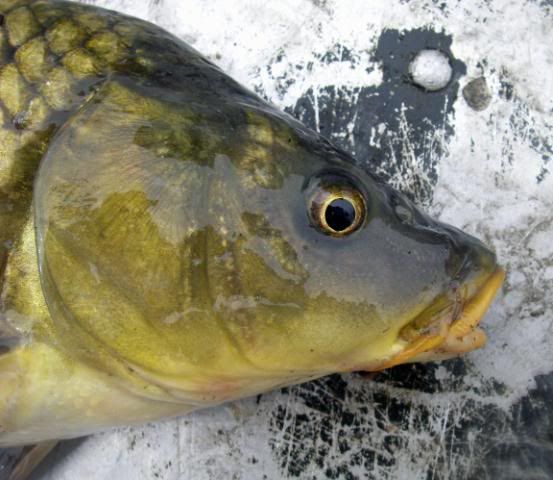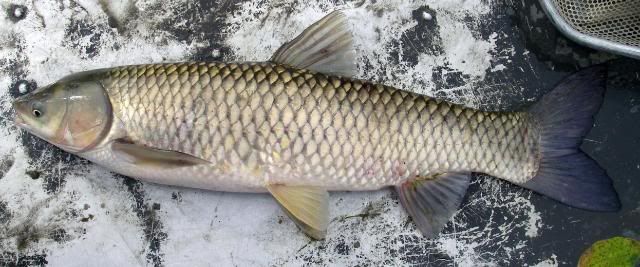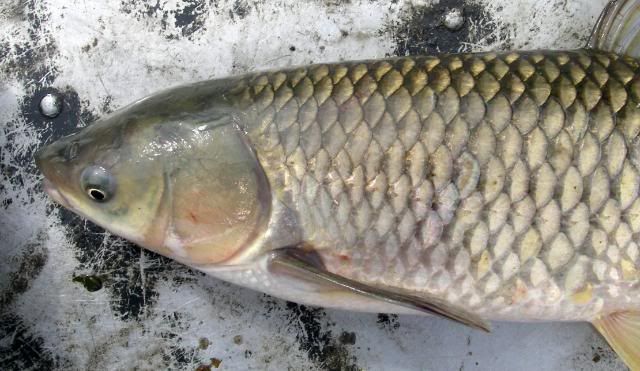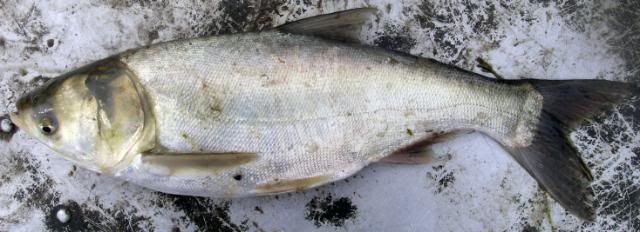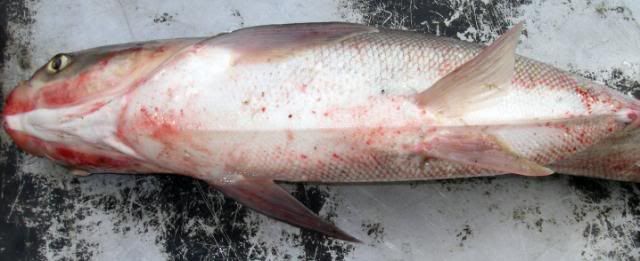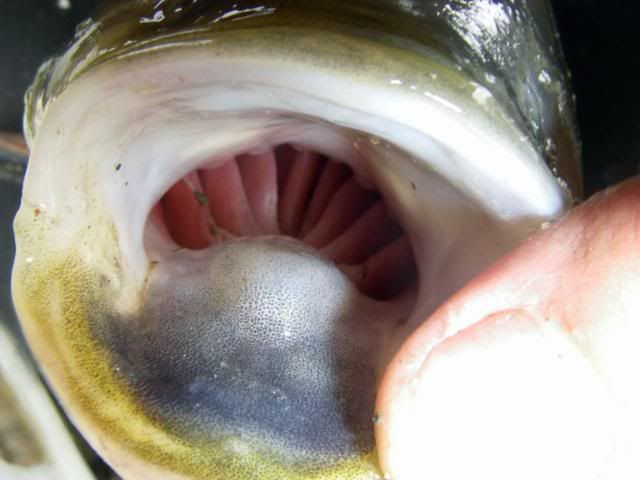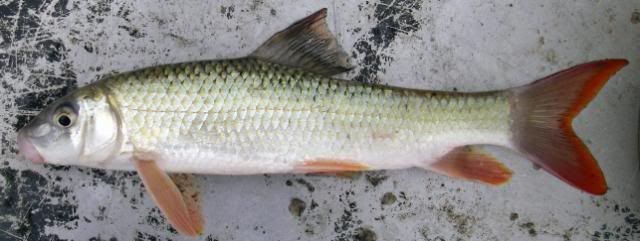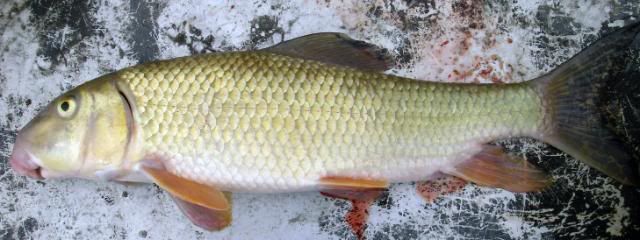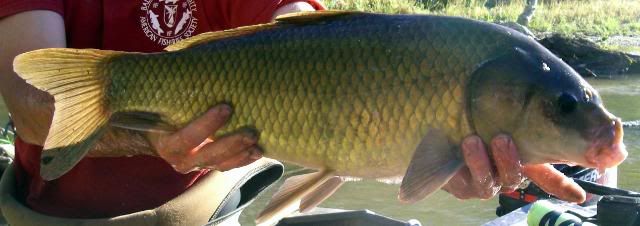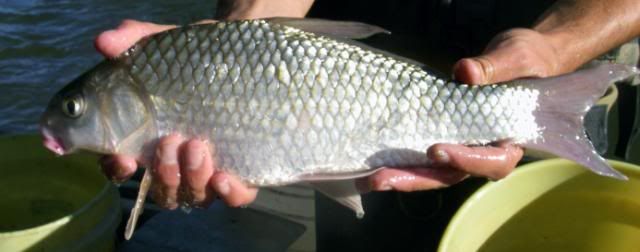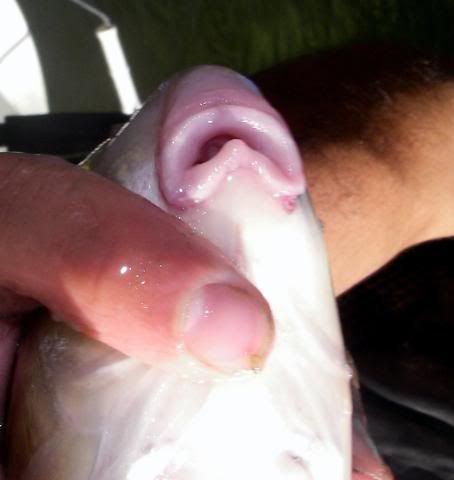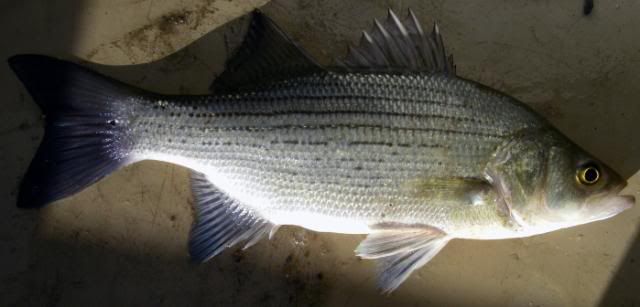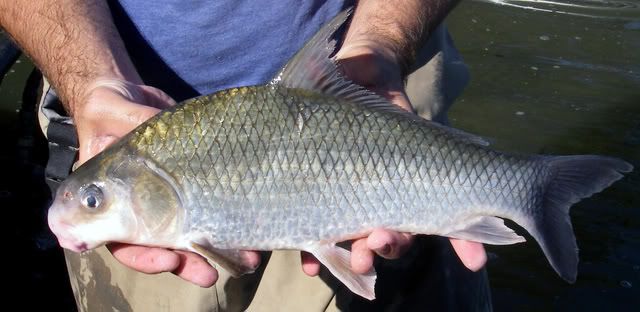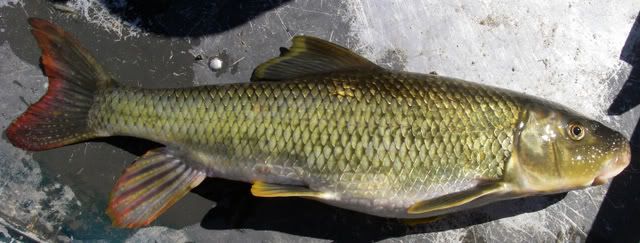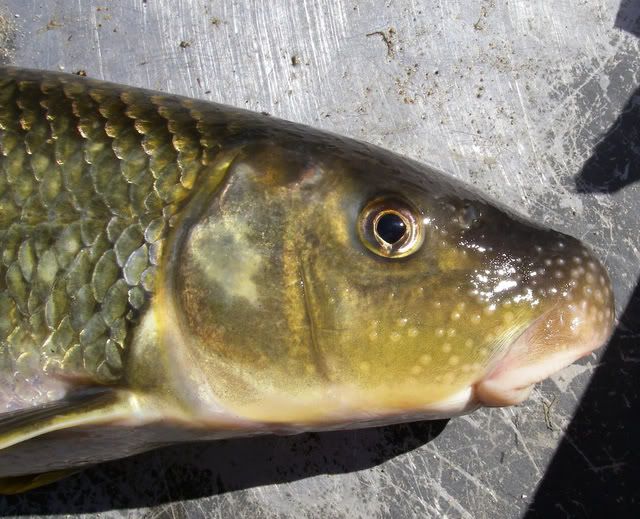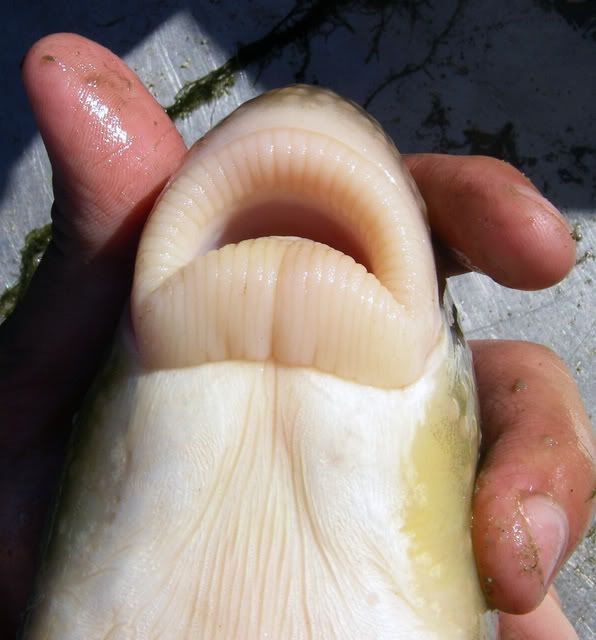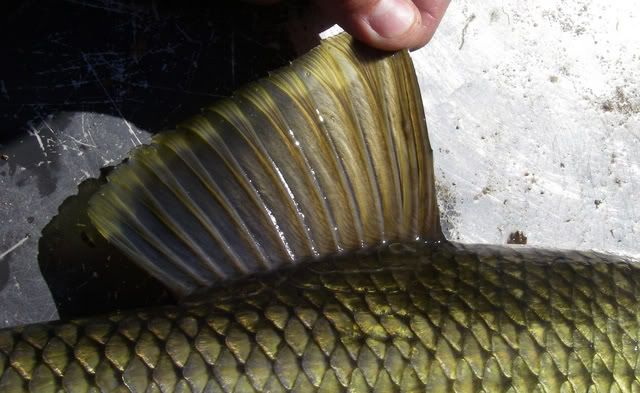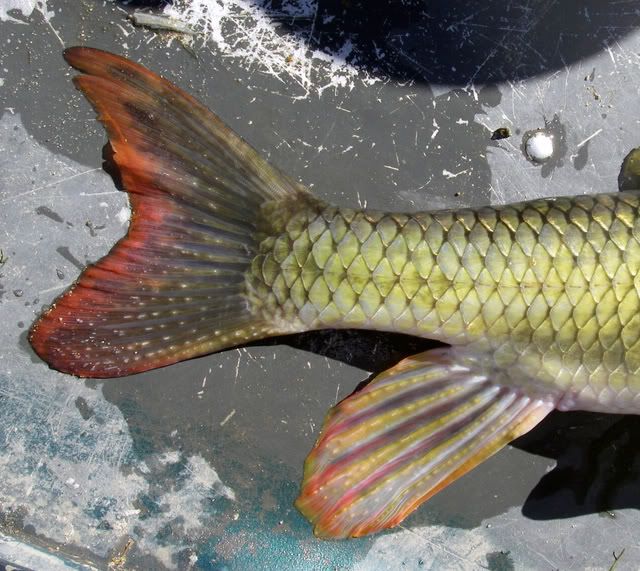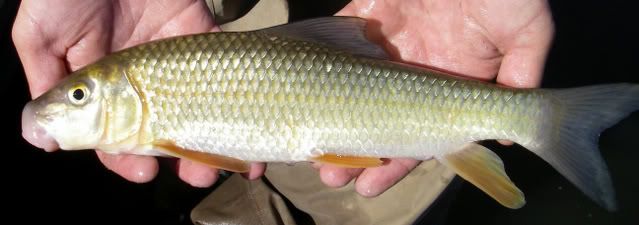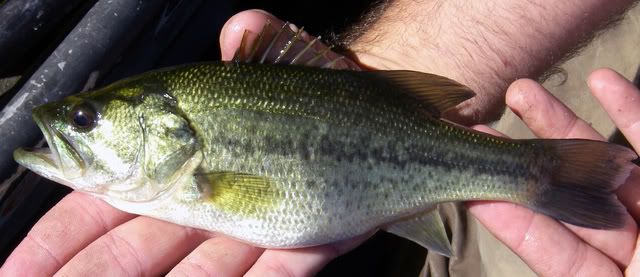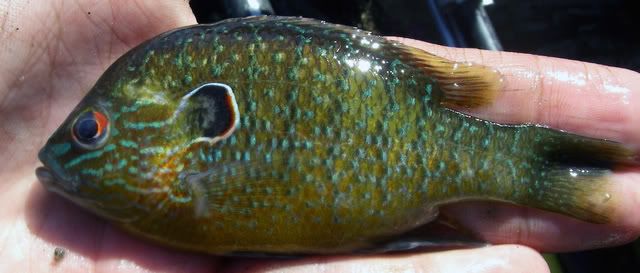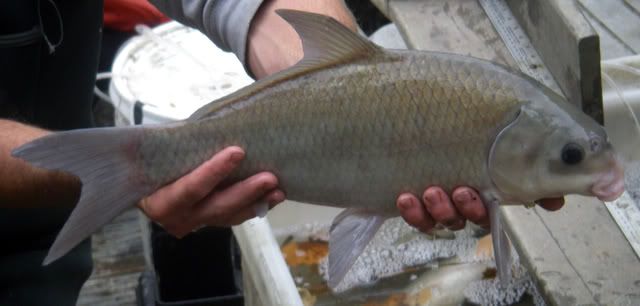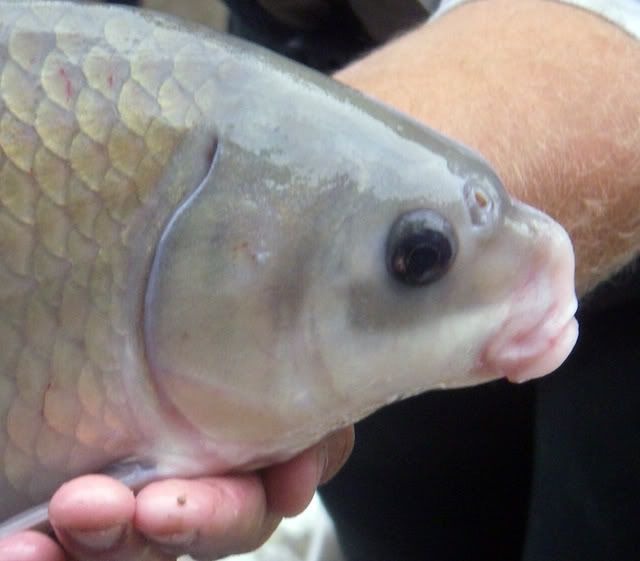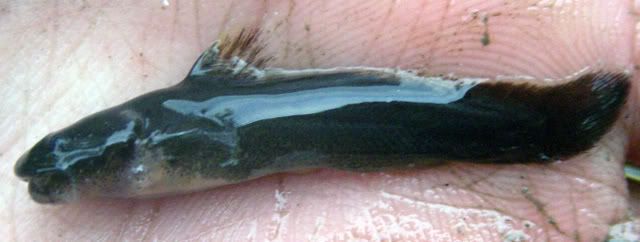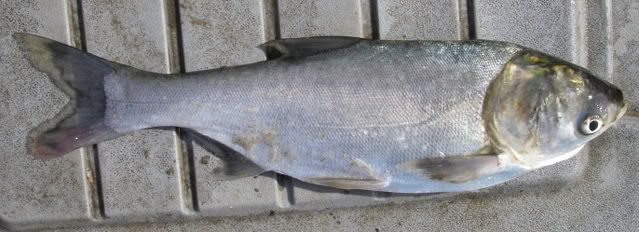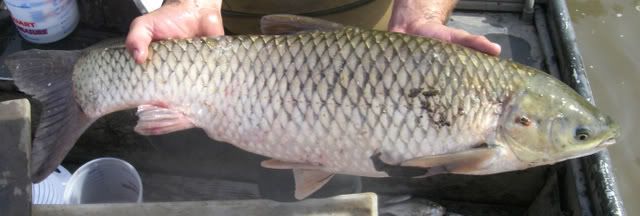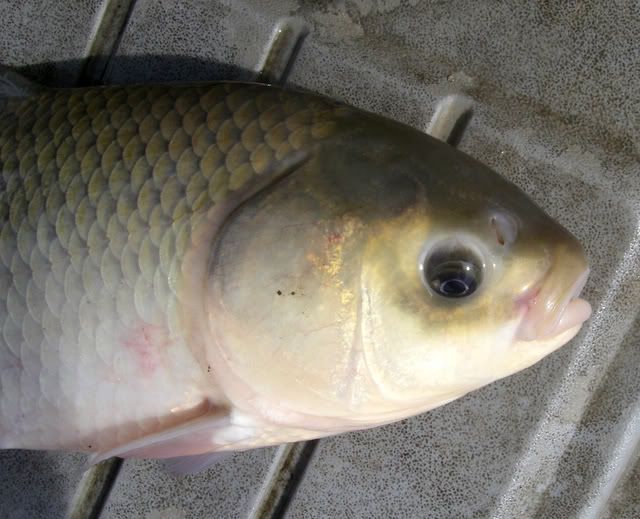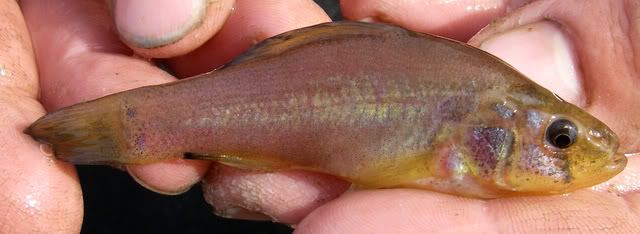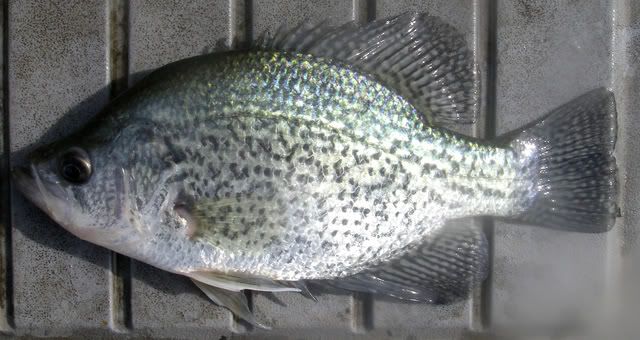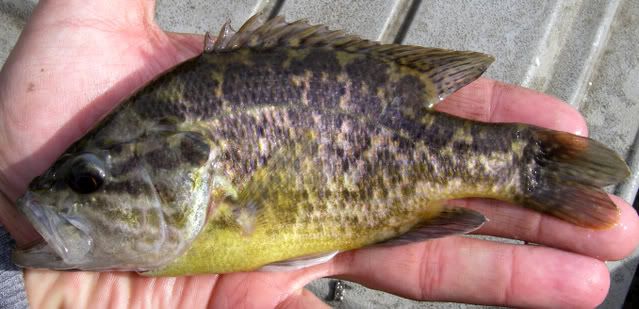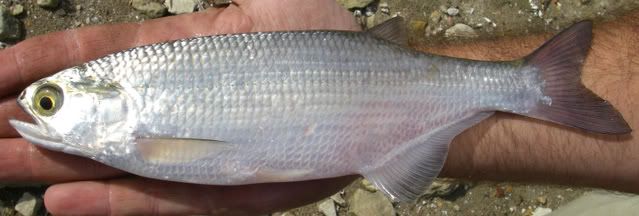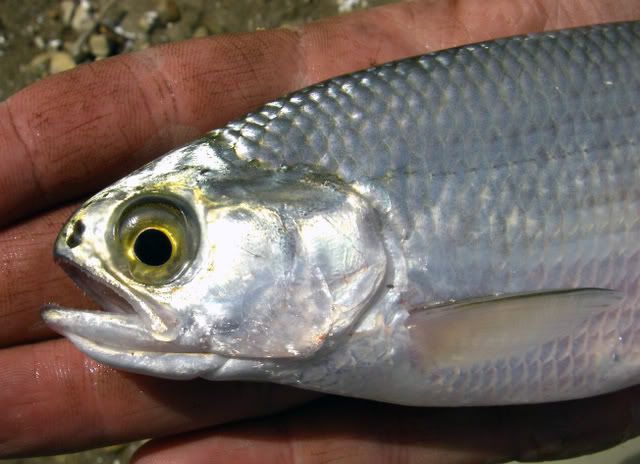Location: South Branch of the Kishwaukee River. South of Cherry Valley, IL. Off Fairydale Rd.
Water Level: Slightly higher than normal levels for this time of year. Max depth 2.3m. Lots of pools and a few gravel/sand runs.
Water Quality: Clearer water than we saw in the main stem of the Kishwaukee. There was good flow through the entire stretch that we sampled and siltation was very low. Overall high quality.
Water Temp.: 16*C
Substrate: Sand and gravel in the runs. Cobble and some large rocks were near the shoreline. At the upstream most area of our sample, there were concrete slabs in place amongst the large boulders to keep the shoreline from eroding (some people built their houses too close to the river it seems). A few large downed trees in the pools congregated massive schools of shiners.
Collected:
Gizzard Shad (Dorosoma cepedianum) just a few in one of the deeper pools.
Northern Pike (Esox lucius)

- only found one small one in the deepest pool. When we found this fish it was near the bottom of the pool as well, near some larger catfish.
Common Carp (Cyprinus carpio) lots of large adult fish.
Hornyhead Chub (Nocomis biguttatus)
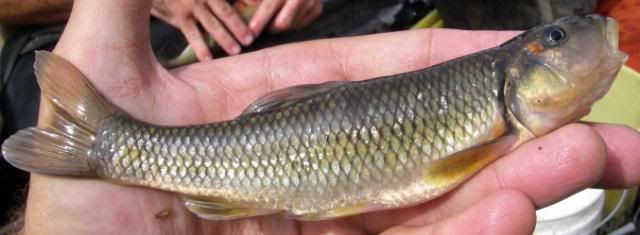

not a large population of them here, but we did find this large adult male.
Central Striped Shiner (Luxilus chrysocephalus chrysocephalus) only caught a few, but we could see large schools of these swimming in the deeper pools.
Spotfin Shiner (Cyprinella spiloptera) very abundant
Bluntnose Minnow (Pimephales notatus) very abundant
Redfin Shiner (Lythrurus umbratilis) only a few.
Suckermouth Minnow (Phenacobius mirabilis) just one, there was suitable habitat for these fish (swift riffles and runs with algae growth), but I felt that the stream was a little small for these fish that I associate with larger, more turbid rivers.
Emerald Shiner (Notropis atherinoides) just a few.
Carmine Shiner (Notropis percobromus) a few of these as well. There was a sandy run that followed a deeper pool that had hundreds of small shiners in and around it. This run in itself had the bulk of our minnow haul.
Central Bigmouth Shiner (Notropis dorsalis dorsalis) found about 6 or 7 of these here. They could have been more abundant, but we werent able to sample every small minnow found here.
Sand Shiner (Notropis stramineus stramineus) very abundant. The sand areas were loaded with these fish of all age classes.
Central Stoneroller (Campostoma anomalum pullum) not very abundant.
Highfin Carpsucker (Carpiodes velifer) a few adults
Central Quillback (Carpiodes cyprinus hinei) a few adults
Northern Quillback (Carpiodes cyprinus cyprinus) a few adults of these fish as well. It wasnt easy to distinguish any habitat preference between Central and Northern Quillback. The Highfin Carpsucker seemed to be found over sand substrates usually. Whereas Quillbacks were prone to sand and/or gravel substrates.
Black Redhorse (Moxostoma duquesnei) lots of really big ones here. It wasnt surprising to find them in this clean of a stream with substrates free of siltation.
Golden Redhorse (Moxostoma erythrurum) lots of big ones here as well.
Silver Redhorse (Moxostoma anisurum) only a few smaller ones here. This could be a function of this site being a smaller stream than some of our other sites.
Shorthead Redhorse (Moxostoma macrolepidotum) these were very abundant here and were mostly adult-sized fish.
Northern Hogsucker (Hypentelium nigricans) Ive never seen Hogsuckers to be more abundant than they were here, and in all size classes. My back was sore from netting all the Hogsuckers that we found here. Everywhere where there was current and gravel, there were tons of Hogsuckers.
Channel Catfish (Ictalurus punctatus) lots of large ones were in every deeper area. The deepest areas harbored the largest fish.
Flathead Catfish (Pylodictus olivaris)
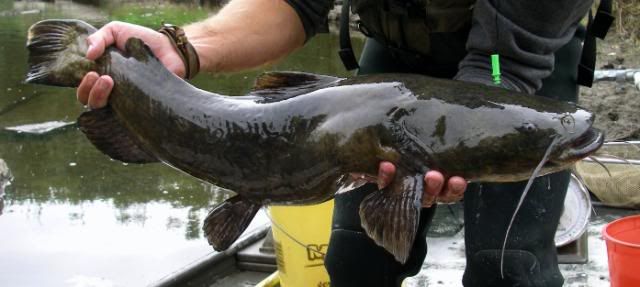
only a few, but the few that we did find were really large (got two at 29 each). The first one we found (pictured) was in a deep, swift run, that was loaded with small Rock Bass and Green Sunfish. I bet this fish was well fed on these small Centrarchids. There were probably lots of crawfish amongst these large rocks in the deep run.
Yellow Bullhead (Ameiurus natalis) only one.
Blackstripe Topminnow (Fundulus notatus) only a few
Brook Silverside (Labidesthes sicculus) only one small one.
Northern Smallmouth Bass (Micropterus dolomieu dolomieu) lots of great habitat for these fish. Perhaps the best Smallmouth Bass habitat we encountered during our time in Illinois. Brian was fishing a little downstream of our site with a small jig for bait. He landed 31 Smallmouth Bass in about 45 minutes out of one pool! With the abundance of forage here for the Smallmouth Bass, this area could be one of the best Smallmouth Bass fisheries in the state.
Rock Bass (Ambloplites rupestris) just as abundant as the Smallmouth Bass.
Green Sunfish (Lepomis cyanellus)
Bluegill Sunfish (Lepomis macrochirus macrochirus)
Johnny Darter (Etheostoma nigrum) found a few in the sandy runs near mixed in with the massive schools of minnows in shallow water.
Banded Darter (Etheostoma zonale)
Freshwater Drum (Aplodinotus grunniens) a few large ones.
Notes: With the quality of this Smallmouth Bass fishery, its no wonder we had such a hard time accessing this site. There is virtually no public access on this stream and in fact we had to sample by accessing private property which we were granted access to by the owner.
Date: September 30, 2007
Location: Kishwaukee River near Belvidere, IL. At Distillery Park at the dead end of Distillery Rd., just off US Business Route 20.
Water Level: Slightly higher than normal. The area sampled had stretches of 1.8 2.1 m deep pools. A few shallow runs were present that emptied into these deeper pools.
Water Quality: A little more siltation than any other site on the Kishwaukee River. The bottoms of the pools were silted and the secchi disk was barely visible at the bottom of the deepest pools.
Water Temp.: 17.39*C
Substrate: At the uppermost stretch of our site (the furthest upstream) the shoreline was rip-rap made of concrete slabs. Where this stretch ended, there was a scoured out pool that was the deepest area of the site. This pool had a sand and gravel bottom with a noticeable amount of siltation. There was a long run that followed the deep pool that had a clean sand and gravel substrate. The furthest downstream point of the site was a large shallow gravel and sand riffle.
Collected:
American Brook Lamprey (Lampetra appendix) one was caught by Brian (he has an eye for Lamprey). If I remember correctly it was found in the sand/gravel riffle area at the end of this site.
Northern Pike (Esox lucius) a few were found in the deep pool that was scoured out. I had a blast here waiting for Brian and Bob to finish up with this site. While they were working upstream, I went downstream of the site and fished some pools I found with a 4 jerkbait. On my second cast I caught a Northern Pike that was probably around 25 long. I left that pool and went down to a pool that had a small feeder creek flowing into it. Where the creek flowed into the river, there was a riffle that emptied into a deep completely sand bottomed pool. A few casts into that pool produced another large pike. After releasing that fish, I began casting in the tailwaters of this pool and caught a few small Smallmouth Bass and had another large pike follow the jerkbait back to me and swipe at it only to barely miss the bait. There seems to be a strong population of adult Northern Pike in this stretch of the river, definitely a spot to revisit.
Common Carp (Cyprinus carpio) only a few large ones here. They were primarily near the large concrete slabs.
Golden Shiner (Notemigonus crysoleucas) a few, like usual, when present they arent present in large concentrations.
Fathead Minnow (Pimephales promelas) one
Bluntnose Minnow (Pimephales notatus) very abundant
Spotfin Shiner (Cyprinella spiloptera) very abundant
Carmine Shiner (Notropis percobromus) not in big numbers
Sand Shiner (Notropis stramineus stramineus) very abundant
Central Bigmouth Shiner (Notropis dorsalis dorsalis) just a few
Central Stoneroller (Campostoma anomalum pullum) very common in the final stretch of the site.
River Carpsucker (Carpiodes carpio) not very abundant, only a few were found here.
Northern Quillback (Carpiodes cyprinus cyprinus) not common here either.
Central Quillback (Carpiodes cyprinus hinei) also not very common. I think because this areas deeper spots had higher amounts of siltation than other spots on the Kishwaukee, the Carpiodes suckers were not drawn to this spot. Also, the Carpiodes sucker that is most commonly associated with clean sand is the Highfin Carpsucker, which was completely absent from this spot.
Black Redhorse (Moxostoma duquesnei) a few large ones. Only a few in comparison to the large number of adult Golden Redhorse we found.
Golden Redhorse (Moxostoma erythrurum) lots of large adult sized fish here. This was another example of siltation increasing and the ratio of Golden to Black increasing as well.
Silver Redhorse (Moxostoma anisurum) a few large ones in the deepest pool.
Shorthead Redhorse (Moxostoma macrolepidotum) lots of big ones towards the beginning of the sample.
Northern Hogsucker (Hypentelium nigricans) very abundant
Channel Catfish (Ictalurus punctatus) 25+ adult fish.
Stonecat Madtom (Noturus flavus) a few
Blackstripe Topminnow (Fundulus notatus)
Northern Smallmouth Bass (Micropterus dolomieu dolomieu) good populations existed throughout this site. Many were pretty large too.
Rock Bass (Ambloplites rupestris) the Rock Bass have pretty similar habitat requirements to the stream inhabiting Smallmouth Bass, so it seems throughout our sampling that any areas that had lots of Smallmouth Bass also had lots of Rock Bass.
Black Crappie (Pomoxis nigromaculatus) one.
Green Sunfish (Lepomis cyanellus) not very abundant.
Bluegill Sunfish (Lepomis macrochirus macrochirus) only a few of these as well.
Northern Logperch (Percina caprodes semifasciata) just one.
Blackside Darter (Percina maculata) a few
Johnny Darter (Etheostoma nigrum)
Rainbow Darter (Etheostoma caeruleum) very abundant in the riffles here.
Banded Darter (Etheostoma zonale) just as numerous as the Rainbow Darter here.
Freshwater Drum (Aplodinotus grunniens) only one. This was a big surprising because I would have expected to see them in higher numbers here.
Notes: This area looked like it would be prime Smallmouth Bass and Northern Pike fishing. There were a lot of pools with good depth and downed trees downstream of this site that surely would hold lots of Northern Pike.


